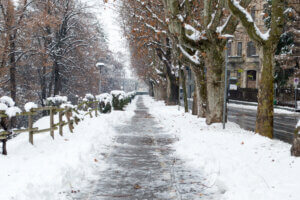Slip and fall accidents can happen in various locations, and it’s essential to be aware of potential hazards to prevent injuries. Here are some common areas where slip and fall accidents often occur:
1. Supermarkets and Grocery Stores
Supermarkets and grocery stores are frequent sites of slip and fall accidents. Spills from liquids, such as water, oil, or other substances, can occur in aisles. Produce sections may also have fallen fruits or vegetables on the floor. The smooth flooring surfaces and potential spills make these areas prone to accidents.
2. Restaurants and Cafeterias
Restaurant kitchens, dining areas, and buffets present slip and fall risks. Spilled drinks, greasy floors, and food debris can create hazardous conditions. Additionally, restaurant bathrooms may have wet surfaces, posing a risk, especially during busy hours.
3. Retail Stores
Retail environments, including malls and individual stores, are susceptible to slip-and-fall incidents. Wet or recently cleaned floors, as well as misplaced merchandise or packaging, can contribute to accidents. Entryways, where customers may track in rain or snow, can also be slippery.
4. Hotels and Motels
In hotels and motels, common areas like lobbies, hallways, and entrances are potential slip-and-fall zones. Wet floors from cleaning or leaking plumbing fixtures, uneven surfaces, or poorly maintained walking areas can lead to accidents.
5. Public Transportation Stations
Train stations, bus terminals, and airports can be hazardous due to weather conditions, spills, and crowded spaces. Platforms, waiting areas, and vehicles may all pose slip and fall risks.
6. Workplaces
Workplaces are not immune to slip-and-fall accidents. Wet or freshly cleaned floors, loose cables, uneven surfaces, and inadequate lighting can contribute to workplace accidents. Industrial settings may have additional risks due to machinery or chemicals.
7. Residential Areas
Slip and fall accidents can also happen in residential areas. Sidewalks, driveways, and steps may become slippery due to weather conditions, leaves, or moss growth. Common areas like lobbies or stairwells may present risks in apartment buildings or condominiums.
8. Public Parks and Recreation Areas
Parks and recreational spaces may have uneven terrain, wet grass, or muddy paths, increasing the likelihood of slip and fall incidents. Playgrounds, especially those with outdated or poorly maintained equipment, can pose risks to children.
9. Healthcare Facilities
Hospitals, clinics, and nursing homes can be locations where slip and fall accidents occur. Spills, wet bathroom surfaces, and transitions between different flooring materials can create hazards, particularly for patients and visitors.
10. Educational Institutions
Schools, colleges, and universities have areas prone to slip and fall accidents. Corridors, cafeterias, and gymnasiums may have wet floors, spilled liquids, or poorly maintained flooring surfaces.
11. Outdoor Events and Festivals
Large outdoor gatherings, events, and festivals may have a variety of surfaces, including grass, pavement, and temporary flooring. Weather conditions, spilled beverages, and crowded areas can contribute to slip and fall risks.
12. Public Restrooms
Restrooms in various locations, including shopping centers, restaurants, and gas stations, can be slippery due to water spills, wet floors, or inadequate maintenance.
Vigilance and Prevention
Preventing slip and fall accidents involves maintaining a vigilant awareness of potential hazards in various environments. Regular inspections, proper maintenance, and implementation of safety measures, such as signage and non-slip flooring, are crucial to minimize the risks associated with these common areas. Businesses and property owners can create safer environments for everyone by addressing potential hazards. If you or your loved ones are affected by a slip and fall accident, contact Attorney Wayne Resmini to assist you with your case.

